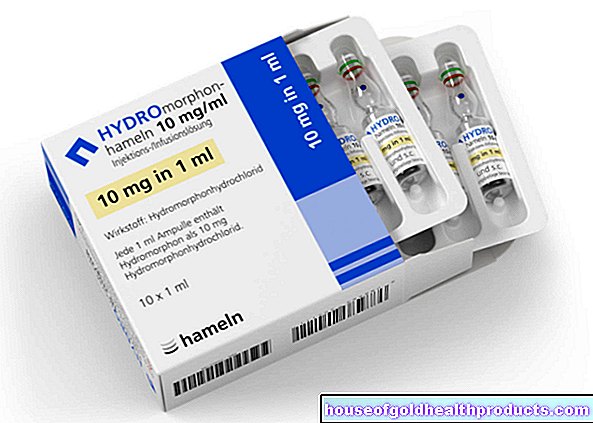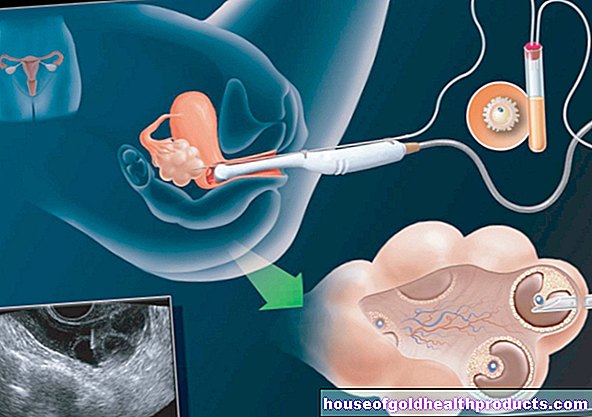Lymphocytes
and Eva Rudolf-Müller, doctorEva Rudolf-Müller is a freelance writer in the medical team. She studied human medicine and newspaper sciences and has repeatedly worked in both areas - as a doctor in the clinic, as a reviewer, and as a medical journalist for various specialist journals. She is currently working in online journalism, where a wide range of medicine is offered to everyone.
More about the experts All content is checked by medical journalists.Lymphocytes belong to the white blood cells, the leukocytes. They are responsible for the defense against pathogens. There are two types of these blood cells: T and B lymphocytes. Here you can read everything you need to know about the two groups, how they differ, what tasks they perform and when the lymphocyte values in the blood change.
What are lymphocytes
Lymphocytes are a subset of the white blood cells (leukocytes). These include the B lymphocytes (B cells), the T lymphocytes (T cells) and the natural killer cells (NK cells).
The lymphocytes are formed in the lymph nodes, the spleen, the thymus and the bone marrow. Most of the cells remain there even after they have formed; only about four percent of the resulting lymphocytes enter the bloodstream.
What are the tasks of the lymphocytes?
After contact with foreign substances such as pathogens, B-lymphocytes develop into so-called plasma cells and produce specific antibodies against the intruder.
The T-lymphocytes and their sub-forms, on the other hand, have other defense functions:
- They regulate the immune system's response to pathogens.
- They fight infected or degenerate body cells (cytotoxic T cells, T killer cells).
- They promote the development of B cells.
- They indirectly support the maturation of the antibodies.
In addition, T lymphocytes are involved in the hypersensitivity reaction in contact allergies.
The T-lymphocytes are also known as memory cells: once they have become acquainted with an antigen (characteristic component of a foreign substance), they can identify it immediately upon renewed contact and initiate a quick specific defense reaction.
Natural killer cells kill virus-infected or degenerate cells.
What are atypical lymphocytes?
The appearance (morphology) of the lymphocytes changes in the course of various diseases. For example, they become larger or the cell nucleus changes its shape. Doctors refer to such altered cells as atypical lymphocytes. They can be found in the blood, among other things:
- certain forms of toxoplasmosis
- rubella
- Inflammation of the liver (hepatitis)
- Mononucleosis (glandular fever, infection with the Epstein-Barr virus)
- Cytomegaly (infection with the cytomegalovirus, CMV)
Lymphocytes: normal values
The small blood count only shows the total number of leukocytes. But if the doctor wants to know how high the proportion of lymphocytes and the other subgroups of leukocytes is, he orders a differential blood count. There, the amount of lymphocytes is usually given as a relative value, i.e. as a proportion of the total number of leukocytes (in percent). Sometimes, however, you can also find an absolute measured value in laboratory results, i.e. the number of lymphocytes per nanoliter of blood. Depending on the age, the following standard values apply:
|
relative value (percentage of total leukocytes) |
absolute value (number of lymphocytes per nanoliter) | |
|
<2 years |
40 - 70 % |
2 - 17 / nl |
|
2 to 5 years |
20 - 70 % |
1.7 - 5.9 / nl |
|
6 to 16 years |
20 - 50 % |
1 - 5.3 / nl |
|
from 17 years |
20 - 45 % |
1 - 3.6 / nl |
When are the lymphocytes increased?
An excess of lymphocytes is called lymphocytosis. It occurs in infancy or childhood as part of many harmless infections.
In adults, too, there are increased lymphocyte values in the healing phase after infections. This applies especially to viral infections such as mumps or measles, but also to bacterial infections such as whooping cough. Chronic infectious diseases such as tuberculosis or syphilis (syphilis) also increase the lymphocyte values.
But even with diseases that are not caused by a pathogen, the lymphocytes can be too high. Examples of such diseases are:
- inflammatory bowel disease such as Crohn's disease or ulcerative colitis
- Inflammation of the blood vessels (vasculitis) such as giant cell arteritis
- Serum sickness (a severe allergic reaction of the immune system)
- hormonal disorders such as Addison's disease or an overactive thyroid (hyperthyroidism)
A particularly pronounced lymphocytosis is found in chronic lymphocytic leukemia (CLL). In this form of blood cancer, the values often rise to over 100,000 / ml.
When are the lymphocytes low?
If the lymphocytes are too low, this is called lymphopenia or lymphocytopenia. It occurs in the following cases:
- Stress reactions
- Therapy with corticosteroids ("cortisone")
- the body's own increased secretion of corticosteroids
- after radiation therapy
- systemic lupus erythematosus
- Diseases of the lymphatic system such as lymph node tuberculosis or non-Hodgkin lymphoma (a type of lymph gland cancer)
Lymphocytes are also low in diseases of the immune system, for example in the case of advanced HIV infection (AIDS).
Tags: teeth alternative medicine first aid














-warten-auf-den-piks-der-freiheit.jpg)














